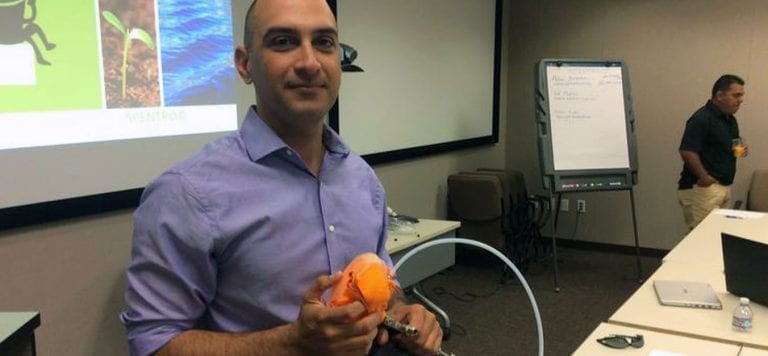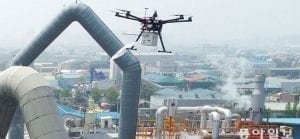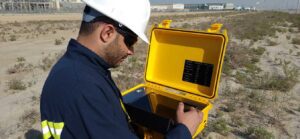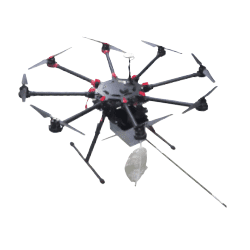By Cathy Proctor – Reporter, Denver Business Journal Sep 11, 2017.
Article originally appeared on: https://www.bizjournals.com/denver/news/2017/09/11/tackling-odor-problems-in-the-oil-fields-is.html
An international team of odor experts hired by Denver’s Crestone Peak Resources has spent about a month in Erie. Their camp situated about 30 miles north of downtown Denver. They spend the day tracking smells wafting from an oil and gas drilling rig near the Vista Ridge neighbourhood.
They found smells, but initial field test results in early September failed to find odors from Crestone’s operations. Nothing reached such levels and intensity that they violated Colorado’s regulations. This is according to Ardevan Bakhtari, the founder of Scentroid, based in Toronto, Ontario, Canada.
“No odor episodes were detected that violated Colorado regulations or international regulations,” Bakhtari said Friday at an information seminar. Crestone convened at its regional office in Firestone for nearly 30 state and local officials, industry experts and others.
Scentroid’s Impact
Scentroid, a 15-employee company in business for seven years, has worked around the world. They have helped clients tracking smelly operations such as factories, Qatar’s massive refinery complex and marijuana use in Toronto. The company, which is considering opening a Denver office, also manufactures equipment used to detect and measure odor levels.
In Erie, Scentroid’s team detected odors over the course of two days of tests at sites around the drilling rig. However, the smells didn’t last long enough, nor were they concentrated enough to violate either state or international standards, Bakhtari said.
The lack of violation-level smells from operations doesn’t mean Crestone should expect to be free from odor complaints, Bakhtari said.
The Power of Individual Olfactory and Odor Complaints
A person’s sense of smell, and their decision to categorizing a smell as “good, bad, neutral or nasty,” is subjective. It ranges from which way the wind is blowing to individual taste, he said.
“You have to have a history with an odor to perceive it as good or bad. It depends on the culture and where you live,” he said.
“If you lived in a city, you could have good memories of city smells. If you lived on a farm you could have good memories of manure.”
Nor is Crestone resting easy on the results of Scentroid’s field tests.
Jason Oates, Crestone’s director of external affairs, said Scentroid will continue to analyze samples taken from the Vista Ridge area at their laboratories.
Scentroid’s Odor Results for Colorodo Oil and Gas Company
As for meeting the state’s standards, “the standard is one thing — but if we can do more — economically and reasonably — we’ll try,” Oates said.
Oates said Crestone is already looking at how to reduce smells from a new source Scentroid’s team uncovered. The mud that clings to the drilling pipe as it’s pulled from the wellbore, a routine part of the drilling operation.
Pulling pipe from the wellbore means the pipe — and the mud it’s come through — is pulled dozens of feet into the air. It rises above the massive soundwalls many companies use to contain the lights and sounds of the drilling rigs. In Crestone’s case at the Pratt site, the 100-foot pipe sections were rising some 60 feet above the 40-foot soundwalls.
Oates said Crestone is looking at ways to cut the odors from the mud on the pipes, such as scraping the mud off the pipe as it’s pulled out of the hole and spraying agents on the pipe that are designed to mask odors.
“Measurement is Key to Improvement…”
“Measurement is the key to improvement and we’ll continue to knock things down as we find them,” Oates said.
“We take this very, very seriously,” Crestone’s president and CEO, Tony Buchanon, told the assembled group prior to Bakhtari presentation. “We do everything that we can in our communities to make it [our operations] as painless as possible.”
Crestone’s sensitivity about odors stems from complaints about its operation and Erie’s new odor law, which took effect on Sept. 1. Crestone has warned the town the law is too subjective and may be illegal.
Oates said Crestone personnel talked to Erie officials about the company’s concerns in recent days and agreed to work closely with the town.
Erie officials, including police officers looking into odor complaints from residents, crossed paths with Scentroid team during the field tests, Bakhtari said.
But as of Friday, Crestone hadn’t been notified that its operations had violated Erie’s odor regulations, Oates said.
New Odor Issues Detected
Scentroid’s team focused on the area around the Pratt drilling rig, which is drilling oil and gas wells near the Vista Ridge neighborhood. The site, and the neighborhood, is southwest of Waste Connections’ active landfill operation.
The location complicates the ability of residents — and the town — to track smells back to their source, Bakhtari said.
Some of the smells may come from the drilling rig. The team traced other smells to the landfill. Still others wafted from passing trucks hauling garbage to the landfill — including rock, dirt and mud unearthed by other drilling rigs working in the area, he said.
“The landfill has a much bigger impact [in terms of odor] than the rigs,” Bakhtari said.
Colorado’s regulations on odors, enforced by the Colorado Department of Public Health and Environment, are pretty good — especially since very few states in the U.S. have regulations, he said.
Measurable levels of Odors for Colorado Oil and Gas
Colorado’s regulations rely on measurable levels of odors, which remove the “he said, she said” element from defining nasty smells and enforcing the regulation, Bakhtari said.
An odor violates Colorado’s residential regulations if it’s detectable after the odor’s been diluted by fresh air by a factor of seven or more, and the odor is detected at that level twice in an hour, with the measurements taken at least 15 minutes apart.
Mitigating nasty smells from an operation — any kind of operation — is a tough nut to crack, according to Bakhtari.
Odor is the result of elements in the air that are sniffed by the human nose and associated with something by the brain. Smell is one of man’s primal senses, he said.
The Power of Odor Psychology
“If there were no people in an area, there would be no odor. It’s not a physical thing, and it plays heavily on the psychology of the people who are smelling it,” he said. “We have one gene to hear, three genes to see, 12 to taste and nearly 1,000 genes defining olfactory scents.”
Odor also is something that’s learned over time. Learning to associate one smell with a strawberry, another with gasoline and labelling other smells like fresh bread or coffee.
The tie between the brain and the smell is a strong one. So strong, that sometimes the brain can play tricks on the person, Bakhtari said.
“The memory of many days of seeing that drilling rig or smelling it will play into a person’s perceptions they can become hyper-sensitive to the smell, or sometimes they can smell it when there’s nothing there they see the rig and then smell things because the brain says there should be a smell,” Bakhtari said.
Colorado Odor Complaint
During Scentroid’s tests, they met with residents complaining about smells. They focused on ones that either didn’t register on the team’s equipment, or barely registered, he said.
“We’d stand with residents and they’d say ‘Don’t you smell it?’ And it would be hard to say no, but no, we didn’t,” he said.
During one meeting, Bakhtari said, the team’s equipment registered three odor units, far below the state’s seven-unit threshold for violations, but the woman said she was smelling a very intense, nasty odor.
“She said ‘Sometimes it’s even twice this strong,’ which would still just be a level six,” he said, still below the state’s threshold for violations.
Lessons Learned
Industries such as wastewater treatment plants, leather factories, pet food factories and others have tried to tackle the issue with varying levels of success, he said.
An initial scent wafting from an industrial operation may not cause much of a reaction in the brain. Then, over a short period of time, the brain often adjusts to smell and tune it out. This results in the individuals’ sensitivity to the scent going down.
But over a longer period of time, the brain might become overly sensitive to a certain smell.
“Your brain starts to get annoyed by the constant distraction and focuses on a smell and becomes sensitive. It’s the brain tuning itself to the smell,” Bakhtari said.
The location of the smell also is important, he said.
“People tend to complain about smells more at their homes than at their work. At home, they’re more defensive.”














